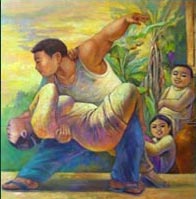
The artist Teoh Kai Suan’s oil paintings were featured in an exhibition on the Muse floor at Artseni Gallery, Starhill,
Using imagery imbued with the idyll of romantic rural life, Teoh sets about encapsulating the noble concept of Balik Kampung, or a return to the kampung, except for Teoh it is a Kampung of the mind, of nostalgia and wish fulfilment.
Unlike the depictions by the illustrious actor and film maker Tan Sri P.Ramlee (born Teuku Zararia bin Teuku Nyak Puteh, in Penang1929), Teoh’s kampung is a calm, un-chaotic, romantic snapshot, while his humour is gentle and homogenous unlike Ramlee’s boisterous rambunctiousness - but just as endearing. In Teoh’s canvases couples dance across the hard trodden earth of the Kampung floor; families, rotund and serene pose for snapshot portraits beneath Rousseau trees. Young kite flyers sprint, stylistically - she clutching her handbag while he holds aloft the kite which is their excuse for being together, both gaze at the viewer. Throughout Teoh’s work the viewer is always present - acknowledged by the characters Teoh has painted. A motorcycle rider squints to see the spectator, while the female dancer purses her lips to blow the observer a kiss. Whether soaking in a river or flying a kite Teoh’s characters benignly engage with the gallery audience.
Teoh’s almost voyeuristic entry into rural (Ulu) Kampung life is reminiscent of the cartoonist Lat’s (Mohammad Nor bin Khalid, b. 1951) work. Lat’s Kampung Boy (1977) charted Lat’s birth and the first few years of his life, based on his recollections of rustic life in Perak. Teoh brings us an altogether different perspective of rural kampung life, in the neighbouring state of Kedah - a more sedate, placid portrayal, enlivened by his vibrant choice of colour. Lat’s humour prods the memory by depicting life in any rural village almost anywhere in the world, except for the fact he is portraying his personal reality, of his own kampung. There is universality to Lat’s character’s antics, a resonance and reflection of rural life the world over.
Teoh too has this ability of capturing moments, snapshots, of rural life, though there is also a stylistic over-layering reminiscent of those Maoist posters seen during
While having similarities to the art of
Teoh continues in this tradition of artists specialising in depicting plump/rotund, larger than life people, just like the Colombian painter Fernando Botero (b.1932,
Echoing Botero and reflecting Latin American artists like Diego Rivera and David Alfaro Siqueiros, Teoh encapsulates the notion of simple, rural home-life. Men wearing sarongs and Japanese slippers serenade along with their children, Chinese eyes wrinkle in smile, cheeks flush with sheer joie de vivre. All is well, and all is right in Teoh’s tranquil pastoral
Teoh’s narrative continues to blend Asian imagery with western figurative tradition and romantic idyll. In many respects we have much to thank Teoh for, his canvases - yes, his hard work - yes, but much more than that - his reminder of what is really important – home and family, thank you Teoh Kai Suan.









No comments:
Post a Comment